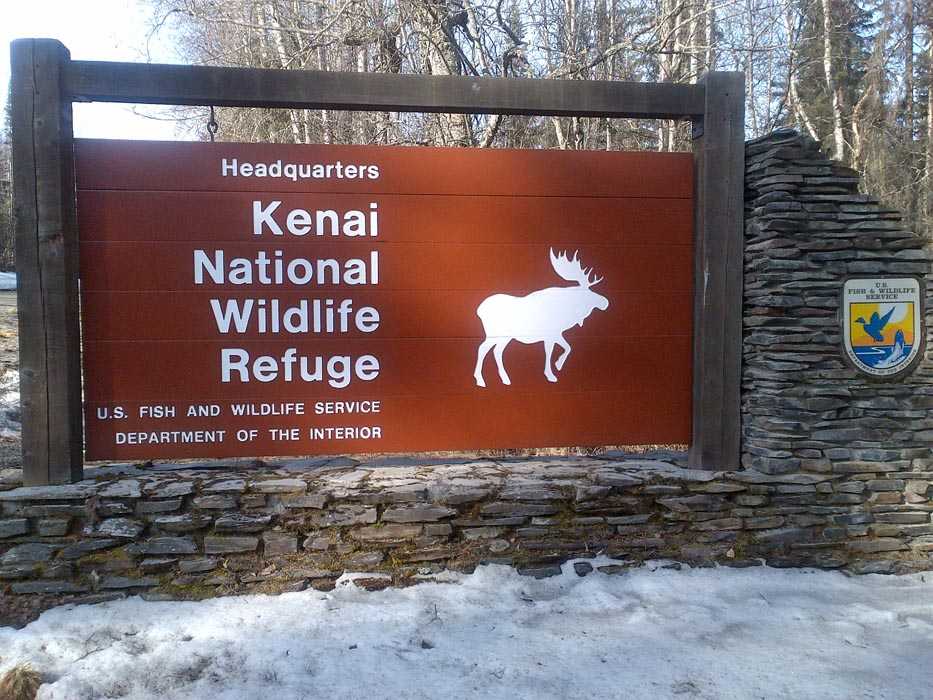As the Kenai National Moose Range approached its fourth decade, Congress passed two laws which profoundly affected its management. The 1971 Alaska Native Claims Settlement Act, signed by President Nixon, addressed land claims of Native peoples throughout Alaska including land claims within the Refuge which, once adjudicated, resulted in substantial withdrawals of surface and subsurface estate. This act also required a review of lands to be set aside for conservation and other values, which led to the Alaska National Interest Lands Conservation Act. Signed by President Carter in 1980, ANILCA designated over 100 million acres of federal conservation system units in Alaska.
Under ANILCA, the Moose Range became the Kenai National Wildlife Refuge. Its purposes were broadened to include conservation of all fish and wildlife and habitats in their natural diversity; meeting international fish and wildlife treaty obligations; protecting water quality and quantity; providing opportunities for scientific research, interpretation, environmental education and land management training; and, in a manner consistent with all of these purposes, providing opportunities for fish and wildlife oriented recreation.
ANILCA also added lands to the new Refuge and established the 1.3 million-acre Kenai Wilderness, forever underscoring the Refuge’s wilderness values and mandating their protection. The newly-designated Wilderness effectively cemented the early vision of Dave Spencer, the Refuge’s first manager, to protect the Kenai’s pristine backcountry.
A guide to implement its expanded mission was needed so the Refuge’s first Comprehensive Conservation Plan was finalized in 1985. To develop this management blueprint, the Fish and Wildlife Service sought unprecedented input from local and national interests. A major purpose of ANILCA was to “… provide the opportunity for rural residents engaged in a subsistence way of life to do so” on federal lands in Alaska. Providing for, and administering subsistence uses of, fish and wildlife resources on the Refuge would become a new responsibility in the 1990s.
The Refuge’s biological program expanded following the passage of ANILCA, and focused on providing information needed by managers to properly balance increasing demands for recreational access with sound conservation of fish and wildlife resources. Cooperative surveys and studies with the Alaska Department of Fish & Game for moose and caribou were conducted. Research and surveys were initiated or expanded for species sensitive to increasing levels of public use, including trumpeter swans, bald eagles, and several furbearing species including wolves, lynx, beaver, wolverine and marten. The Interagency Brown Bear Study Team, composed of biologists from ADF&G, Chugach National Forest, Kenai Fjords National Park and Kenai Refuge, was launched to help ensure the conservation of Kenai brown bears. Kenai Fish & Wildlife Field Office colleagues helped obtain needed information about fisheries resources on the Refuge.
Roadside recreational development on the Refuge expanded with new and improved facilities at Russian River, Skilak Loop, Hidden Lake and Swanson River and Swan Lake Roads. Thousands of new visitors soon discovered these gems. An enhanced system of trails was developed, its subsequent maintenance coincidentally creating great opportunities for involving young people in public lands stewardship through programs such as the Youth Conservation Corps.
In 2005, a plan was finalized for the management of Refuge public use cabins. Through new construction and restoration of historic structures, 16 cabins are now available for the public’s enjoyment. Several trails and cabins were added within the Skilak Wildlife Recreation Area, now managed with an emphasis on wildlife viewing. Growth of the Refuge’s environmental education program culminated in the 2003 opening of the Environmental Education Center adjacent to headquarters on Ski Hill Road.
The 25-year old Comprehensive Conservation Plan was revised in 2010 to bridge the lessons and successes of the past with challenges of the future. Today, collaborative fish and wildlife research studies and surveys continue, but new challenges have emerged requiring a different scientific focus. Refuge biologists are working to understand and help plan for the impacts of a rapidly warming climate on fish and wildlife. Even as biologists have documented over 2,000 species on the Refuge, they are also examining how invasive plants and animals threaten this natural biodiversity. Management now emphasizes early detection and a rapid response to prevent new invasive infestations in still-pristine areas.
Two recent human-caused fires — the Funny River Fire in 2014 and the Card Street Fire in 2015 — highlight the challenges posed by a rapidly developing wildland-urban interface and the continuing need to manage fire for ecological benefits to natural systems on the Refuge. As a result, the Refuge has expanded cooperative efforts with its interagency partners to reduce hazardous fuels near communities.
In May 2015, the Refuge dedicated a new state-of-the art Visitor Center. The building includes “green” features: a sod roof, solar panels, a cozy masonry fire place, and energy efficient floor-to-ceiling windows that offer sweeping views of lake and mountain scenery. The exhibit hall welcomes visitors to explore the Refuge from “Icefield to Ocean” with colorful, interactive exhibits representing the diverse wildlife and their habitats on the Refuge. An expansive multi-purpose room gives a new venue for Refuge and community wildlife education programs.
Today, as we celebrate the Refuge’s 75th anniversary, Refuge staff do their best to serve residents and visitors alike. Visitor Services staff strive to maintain high quality recreational opportunities, and the Visitor Center and Environmental Education Center are hubs where creative programs connect youth with nature in ways that foster life-long appreciation. Refuge law enforcement officers work diligently to ensure natural and cultural resources are protected and visitors remain safe. Our highly skilled maintenance staff provide safe and welcoming facilities for Refuge visitors. Administrative professionals are the foundation which facilitates all of the Refuge’s work. Finally, community support and partnerships are recognized as critical to ensuring effective conservation into the future, working within and beyond Refuge boundaries.
Andy Loranger is Refuge Manager of the Kenai National Wildlife Refuge. The public is cordially invited to help celebrate the Refuge’s 75th anniversary on Friday, December 16 from 5-7 p.m. at the new Refuge Visitor Center on Ski Hill Road in Soldotna. For more information, please call 907-262-7021.

